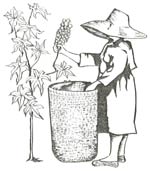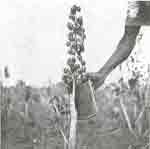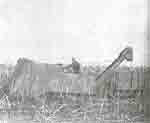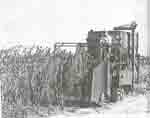- The most difficult and time-consuming operation in the
growing of castor was for many years that of harvesting.
- When the crop was grown on a peasant scale with all operations
manual, this was of little importance.
- There was frequently no competition from other crops with
high labour demands, since castor was usually grown in areas
unsuitable for other crops with high labour demands, since
castor was usually grown in areas unsuitable for other cash
crops, or their harvesting was completed before the castor
matured.
- When grown as an intercrop or on odd scattered patches, the
labour required for harvest was small, and could be carried
out at the owner's convenience.
- Growing interest and increasing world demand for castor oil
encouraged large-scale plantings.
- These were often of local giant types, and it was soon apparent
that economic production with adequate returns to growers
except by planting the more resistant local types.
- The second could be so influenced, and the selection followed
by breeding the dwarf types suitable for fully mechanized
types, machinery was developed which either stripped off the
capsules for later hulling, or combined both operations in
one machine.
 Top
Top
Manual Harvesting

|
- Where castor
seeds were merely collected from wild or naturalized
plants, their harvesting involved picking the clusters,
knocking them against some suitable tree or rock and
picking up the released seeds, or the clusters would
be trodden under a horny foot until shattered.
|

|
- Where a number
of clusters were collected by children or women, they
would be brought back to the homestead for threshing.
- Then they were either placed in a sack and struck
until hulled, or laid on the ground and beaten with
a stick.
|
- The price realized for such seed was low, for the quality
was often poor, and leaving hulled seeds in the hot sun reduced
their oil content.
- The search for alternative cash crops in many tropical countries
resulted in the increased planting of castor, sometimes on
a fairly large scale.
- It quickly became obvious that harvesting and hulling of the
crop was the major problem to be solved, since many of the
indigenous and giant types planted showed considerable resistance
to insect attack.
- Where labour was available, harvesting and hulling could be
carried out on traditional lines, the operation then becoming
a full-time occupation during the period.
- But where labour was short, some form of mechanical harvesting
or hulling was essential.
- Similar methods of reducing labour and speeding these operations
have been developed in many regions of the world.
- The clusters are usually stripped by hand, the unshelled seed
being taken to a central depot for hulling.
- Harvesting of the giant types, the clusters were often so
high above the ground that it was necessary to climb the tree
to pick them.
- Frequently, through idleness, a whole branch was slashed off
irrespective of the proportion of ripe or unripe clusters.
- In both instances considerable damage to the plants occurred
with a major reduction in potential yield.
- Long-handled harvesting shears and knives were introduced
to cut off the whole cluster, and were very successful.
- Hand-reaping is carried out most efficiently by means of a
reaping jug, or stripping cup.
- This is a metal container, shaped like a cone or large beer
mug, 20-30 cm high and approximately 20 cm across the open
end. Opposite the handle is a slot extending 10 cm from the
mouth of the cone, tapering from 2.5 cm wide at the top to
1.25 cm at the bottom.
- The edges of the slot may be reinforced, if required. With
a more hard-wearing metal plate.
- Reinforcing the edge of the slot allows the cup to be made
from thinner material, and substantially reduces its weight.
- This is important where large areas have to be reaped, as
workers become less tired.
- Clusters are reaped by guiding the base of the spike into
the slot, and drawing the jug upwards so that the capsules
fall into the jug.
- Seeds not mechanically hulled were shelled by spreading the
capsules 15cm deep on a threshing floor in the sun.
- Within 5-6 days most of the capsules will have shattered.
- It is desirable to surround the area with corrugated iron
sheets, as the seeds shoot out with some force when the hulls
shatter.
- This hand-reaping system is used for harvesting dwarf castor
with considerable success.
- Mature racemes are cut by hand and transported to central
threshing areas in sacks or baskets.
- These threshing floors can be natural areas of hard soil or
rock, or specially constructed of concrete or paving.
- Hulling is by beating with sticks after the capsules have
been spread in the sun to become thoroughly dry.
- Small hullers have been obtained co-operatively in some districts,
and operate at these threshing floors.
- Both large and small-scale plantings in Brazil are mainly
hand-harvested, and the ripe clusters transported to a central
hulling point.
- Clusters were stripped off plants using a heavy leather glove,
or broken off complete.
- They were then drawn through the U notch cut in a steel plate
fixed in the collecting basket.
- Capsules are sometimes hulled by rubbing on a corrugated rubbing
board, but this is a time-consuming operation and is little
practices.
- On the Indian continent where many of the indigenous cultivated
varieties are not so tall as in other parts of the world,
harvesting is consequently more simple.
- Harvesting operations are generally spread over a period of
five to ten weeks, and between four to six pickings are necessary.
- Highest yields are obtained where the clusters are harvested
at maturity, tied in bundles and hung to dry, but normal practice
is to harvest the crop when a few fruits on each spike ripen.
- The many immature seeds harvested in the process reduce the
quality and quantity of the crop.
- In southern India the harvested capsules are placed in heaps
over which cow-during water is sprinkled to soften the husk
and assist shelling.
- This local practice is based on a belief that this imparts
a good colour and gloss to be seed.
- The treated heaps are covered with straw and weighted to exclude
air.
- In northern India, capsules may be buried in pits and covered
with dung and earth.
- This is considered to assist ripening of immature fruits and
facilitate milling.
- After four to ten days the capsules are spread in the sun
to dry.
- In China harvesting is by the traditional local method
- Clusters are snapped or cut off, tied in bundles on racks
similar to those used for drying paddy, or stooked in pyramids
in the field to dry and later threshed by hand.
- Clusters may be stripped using a metal or wooden plate with
a V-notch fixed above a large wicker basket, or a plaited
cup with U-shaped notch.
- Hulling is usually carried out by beating with flails or sticks,
the mixture of seed and hulls being cleaned by wind-winnowing.
 Top
Top
Mechanized Harvesting

|
- The introduction
of dwarf types of castor and the development of strippers
and combine harvester-hullers allowed full mechanization
of the crop.
- Development of castor harvesters was carried out mainly
in the U.S.A. and the first complete castor harvester
was made at the University of Nebraska in 1945.
|
- By 1956 combine harvesters were being manufactured commercially.
- The harvesting operation consists of removing the seed capsules
from standing plants by the use of low-frequency vibration
induced in the plants.
- This is accomplished by use of a beater mechanism that strikes
the plant stem directly under the lowest raceme.
- Capsules are then conveyed to a huller.
- The hulls are removed in a drum which rolls the hulls off
the seed between two rubber surfaces having a differential
motion.
- The hulls are separated from the seed by a cleaning device
and blown out of the machine to the ground.
- The clean seed is then elevated into a storage bin mounted
on the harvester.
- The harvesting of seed crops requires great care and special
skill in operating combines.
- Where plots are small, hand-harvesting is to be preferred
if at all possible.
- Hulling can be mechanical, but hullers should be run at slow
speeds, feeding should be regular, and capsules should be
quite dry.
- Hulled seeds should be sorted immediately to remove those
with damaged testa, dried of surplus oil from broken seed,
and dusted with an insecticide if required.
 Top
Top
Combine Harvesters

|
- The combine
harvesters now available are relatively expensive,
and require a minimum of approximately 200 hectares
for economic performance.
|
- This should be as far as is possible in large blocks,
for the purchase of a machine to be used on scattered small
plots of local cultivators, even where the total is greater
than the minimum required, would not be economic.
- The loss of time travelling between work, and the general
wear and tear resulting from using specialized and heavy equipment
on often badly constructed and maintained roads, had frequently
resulted in expensive machinery, rashly purchased, causing
financial ruin to enthusiastic but inexperienced farmer co-operatives.
- A two-row machine is cover some 120-200 hectares per season,
working at a rate of 0.75-1.0 hectares per hour.
- Four-row harvesters are available, but are not as popular
as the two-row type.
- They are slower in working, and the volume of seed passing
through the conveyors and hulling discs is such that, except
under ideal conditions, breakdowns and stoppages are more
numerous than with the smaller machines.
- The two-row machines are said by the manufacturers to operate
most efficiently at approximately 5 k.p.h., harvesting at
the rate 0.75-1.5 hectares per hour in castor fields that
yield 3000 shelled seed per hectare .
- Operators also vary greatly in technical skill and ability
to use harvesters to the best advantage, and this is more
important with castor than many other crops, since damaged
seeds are valueless.
- Header attachments can be obtained to harvest either dwarf-or
normal internode castor plants, grown in 90-100 cm rows.
- The rate of working depends almost entirely on the operator,
since it is necessary to adjust the setting for individual
crops and frequently during the actual harvesting operation.
- Harvesting losses can be kept below 5 percent by correct machine
adjustment and by employing a skilled operator, provided good
crop and weather conditions exist.
- However due to the nature of the crop, harvesting losses can
become excessive with careless and improper machine operation,
particularly when the seed is dry.
- Whatever type of harvester is used, it is primarily designed
to harvest ripe, dry capsules and mature seed before the plant
becomes brittle.
- Too long delay at harvest will result in losses by shattering
and fracture of stems and branches.
- Capsules must be dry to hull properly, and are then easily
shaken from the plants.
- Moist capsules do not hull easily, and excessive seed damage
can occur in such conditions.
- Hulls and trash are ejected from the rear of the machines,
and some are fitted with spinners to ensure even distribution.
- These hulls are a useful fertilizer, and contain approximately
1-6 percent nitrogen, 0.1 percent phosphorous and 3.8 percent
potassium, besides adding to the humic content of the soil.
- Whenever possible, commercial hybrid castor plantings should
be harvested by a combined harvester-huller.
 Top
Top
Defoliants
- The majority of the machines available are designed to
harvest seed when the capsules and plant leaves are dry and
the relative humidity below 45 percent.
- At harvest the plants may be still growing, and the later-flowering
spikes may bear immature capsules.
- These green capsules must be dried, and the leaves removed
before harvesting.
- This is often accomplished naturally by killing frosts, and
seed is ready for harvesting some ten days after such frost.
- Where frosts do not occur or are too late, aerial application
of chemical defoliants can be made ten to fifteen days before
harvest.
- Dinitro (DNAP) 3 litres in 20 litres oil was originally recommended
for a single application, or half this rate in two applications,
the first two weeks, and the second one week, prior to harvesting.
- Where temperatures below 29 0 C are expected PCP at the rate
of 0.6-1.7 kg per hectare a.i. should be used instead of (DNAP).From
aircraft, the suggested rate is 3 litres aerial Gramoxone
in at least 60 litres water per hectare.
- This is preferably applied by fixed-wing aircraft, fitted
with either 'Micronair' or fine jets, flying as low over the
crop as possible.
- Alternatively a helicopter can be used, but is usually more
expensive.
- When spraying bipyridyl herbicides, this should preferably
be carried out in the evening.
- Diquat at 4.0 kg. a.i. per hectare applied when all capsules
had turned brown was most efficient, and gave the minimum
yield reduction .
- Aerial application of magnesium chlorate at 15 kg per hectare
in 100-150 litres of water successfully defoliated plants.
- This chemical caused gradual death of plants following leaf-fall.
- The relatively slow defoliation of the leaves increased the
flow of assimilates to the seeds, and resulted in increased
seed weight and oil yield per hectare.
- Defoliation may also increase yields by allowing harvesting
earlier than would normally be possible.
 Top
Top
Hulling
- On an average, castor produces 4-5 sequential order spikes
which can conveniently be harvested in 3-4 pickings starting
from 90-120 days at intervals of 25-30 days, Premature harvesting
leads to reduced seed weight, oil content and germinability.
- Since shattering is not a problem in any of the currently
recommended improved varieties and male parents of any specific
order spikes harvesting can be delayed until all capsules
in the spike are fully dried.
- Even though the locules open in some non-dehiscent types,
the membrane covering the seeds remain intact and hence the
seed does not fall out to the ground.
- However incase of VP-1 which is provide to be partial shattering,
harvesting has to be done little early.
- In such cases harvesting the spike as soon as the colour of
capsules changes from green to yellowish brown and few capsules
start drying.
- Allow the harvested spikes remain in the sun for 3-7 days
before they are threshed/seperated.
- Seeds may be seperated from capsules either manually or mechanically.
 Top
Top
Storage Of Seed
- Castor-seed is very hard and does not require much care
during storage.
- No insect or fungus attacks the seeds. Under ordinary conditions
of storage in jute (gunny)bags, the oil and the free fatty
acid content of the seeds are not affected even after three
years of storage.
- Usually, castor - seeds are not required to be stored in warehouses
over long periods.
- Being an important industrial and export commodity, it is
immediately crushed locally or exported.
- In warehouses, castor seed is stored in gunny bags.
- Sometimes, if the bags get wet due to high humidity or leakage
of rain-water, the seeds become slightly mouldy but this dies
not affect either the oil or the free fatty acid contents.
- With sun drying, the source of damage can be eliminated.
It is recommended that castor seeds be dried to 7-8% moisture
content before storing.
- At domestic or farm level, storage of large quantities of
castor seed is not recommended as it occupies a considerable
space
- Castor seed is also not recommended to be stored in open as
both heat and sunlight damage the germination and reduce the
oil content.
- Artificial low temperature storage also affects the viability.
- Castor seed stored at 5 to 70C temperature for 6 months reduced
the germination from 93 to 3%.
- During bagging the seeds, handling should be minimized. On
large scale handling, wooden scoops, shovels and rubber conveyor
belts are recommended.
- Seeds should be stored at dry place and cooler part of the
house.
 Top
Top
|
|
